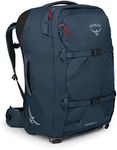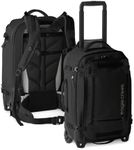Buying Guide for the Best Lightweight Carry On Luggage
Choosing the right lightweight carry-on luggage can make your travel experience much more enjoyable. The key is to find a balance between weight, durability, size, and features that suit your travel needs. Here are some important specifications to consider when selecting the best carry-on luggage for you.WeightWeight is a crucial factor because it determines how easy it will be to carry and maneuver your luggage. Lightweight luggage typically ranges from 4 to 7 pounds. If you travel frequently or have to carry your luggage for long distances, opting for a lighter option (around 4-5 pounds) can save you a lot of effort. For those who need more durability and don't mind a bit of extra weight, a slightly heavier option (6-7 pounds) might be more suitable.
SizeSize is important to ensure your luggage meets airline carry-on requirements and fits in overhead compartments. Most airlines allow carry-ons up to 22 x 14 x 9 inches. If you often fly with budget airlines, you might want to check their specific size limits, as they can be stricter. Choose a size that maximizes space without exceeding these limits, especially if you tend to pack a lot or bring back souvenirs.
DurabilityDurability ensures your luggage can withstand the rigors of travel. Look for materials like polycarbonate, ballistic nylon, or aluminum, which offer good protection against impacts and wear. If you travel frequently or carry valuable items, investing in a more durable material is wise. For occasional travelers, a less robust but still reliable material might suffice.
WheelsWheels affect how easily you can move your luggage. There are two main types: two-wheel and four-wheel (spinner) designs. Two-wheel luggage is better for rough terrain and curbs, while four-wheel luggage offers better maneuverability in tight spaces like airports. If you often navigate crowded areas, four-wheel spinners are ideal. For those who travel to places with uneven surfaces, two-wheel options might be more practical.
HandlesHandles are important for comfort and ease of use. Look for telescoping handles that can be adjusted to your height and have a comfortable grip. Some luggage also features side and top handles for easier lifting. If you have back issues or need to carry your luggage up stairs frequently, ergonomic and well-placed handles can make a big difference.
Compartments and OrganizationCompartments and organization features help keep your belongings tidy and accessible. Look for luggage with multiple pockets, dividers, and compression straps. If you travel with electronics, consider options with padded compartments for laptops or tablets. For those who like to stay organized, luggage with various compartments can make packing and unpacking more efficient.
Security FeaturesSecurity features like TSA-approved locks and anti-theft zippers can protect your belongings. TSA-approved locks allow security personnel to open your luggage without damaging it. If you carry valuable items or travel to places with higher theft risks, these features are particularly important. For general travel, basic security features should suffice.




















